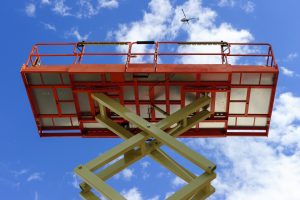Print a Sign-In Sheet | Spanish Version Coming Soon
A scissor lift is an elevated work platform that helps move workers vertically and to different locations in a facility or on a jobsite. Whether it is part of everyday use or part of your maintenance duties, such as changing light bulbs in your facility, most companies have a scissor lift or a need for using one.
When scissor lifts are not used properly, serious accidents can occur. The majority of the injuries and fatalities that occur while working off scissor lifts occur because the following items were not followed: fall protection, stabilization, and proper positioning.
Here are some things to take into consideration to make sure employees work safely with scissor lifts:
- Follow manufacturers’ instructions and recommendations at all times.
- Wear required personal protective equipment (PPE).
- Evaluate and assess your work area for hazards and verify that all effective safety controls, such as fall protection, positioning, and stabilization, are put in place before work is started.
- Fall protection, such as guardrails, must be installed on scissor lifts to prevent workers from falling.
- Never stand on guardrails to perform work. This puts you at greater risk of falling. Keep work within reach.
- Never work off a ladder while working in a scissor lift.
- Some, but not all, manufacturers may require a full-body personal fall arrest harness to be worn while operating a scissor lift. Make sure the operator ties off to the correct anchor point that has been established by the manufacturer.
- Ensure the scissor lift is stable and will not tip over or collapse when in use.
- Choose work locations on a firm, level surface. Watch out for drop-offs, holes, bumps, trash/debris, etc.
- Barricade or isolate scissor lifts so other equipment or vehicles cannot come in contact with the lift. You may need to implement traffic control.
- Only use a scissor lift outside when weather conditions are good. Make sure to avoid high winds.
- Never exceed the weight limit on the work platform.
- Never use other pieces of equipment to lift a scissor lift. (Sometimes a forklift is used to lift the platform so higher areas can be reached.)
- Make sure all safety systems designed by the manufacturer are operational.
- Always position the scissor lift to avoid crushing and electrocution hazards.
- Be watchful when moving a scissor lift near a fixed object or when passing under a fixed object.
- Position scissor lifts away from energized power lines and electrical equipment. This helps avoid electrical shock, electrocution, arc flash, and thermal burns. Stay back 10 feet from overhead powerlines. Injuries and accidents can still occur even if the scissor lift and the worker do not come in contact with the power line.
- If job tasks require workers to work near an electrical source, make sure the worker has been trained and is qualified to work around electricity.
- Employers must regularly maintain the scissor lift to ensure it is safe for use. Follow manufacturers’ recommendations on maintenance and inspection guidelines.
- Before use, test and inspect all controls, components, hydraulics, brakes, tires, and equipment.
- Only trained workers can operate a scissor lift. Employers are responsible for training employees on the proper use of scissor lifts. Training should consist of operating procedures, worksite hazards employees may encounter, manufacturers’ requirements, maintenance and inspection, and how to report an equipment defect or accident.
KEMI does not assume liability for the content of information contained herein. Safety and health remain your responsibility. This information is to be used for informational purposes only and not intended to be exhaustive or a substitute for proper training, supervision, or manufacturers’ instructions/recommendations. KEMI, by publication of this information, does not assume liability for damage or injury arising from reliance upon it. Compliance with this information is not a guarantee or warranty that you will be in conformity with any laws or regulations nor does it ensure the absolute safety of any person, place, or object, including, but not limited to, you, your occupation, employees, customers, or place of business.

